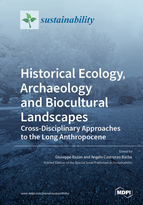Historical Ecology, Archaeology and Biocultural Landscapes: Cross-Disciplinary Approaches to the Long Anthropocene
A special issue of Sustainability (ISSN 2071-1050). This special issue belongs to the section "Sustainability in Geographic Science".
Deadline for manuscript submissions: closed (30 June 2021) | Viewed by 42397
Special Issue Editors
Interests: landscape ecology; vegetation science; botany; biodiversity biocultural landscape; historical ecology
Special Issues, Collections and Topics in MDPI journals
Interests: medieval archaeology; landscape archaeology; historical ecology; GIS
Special Issues, Collections and Topics in MDPI journals
Special Issue Information
Dear Colleagues,
From the micro to the global scale, the human impact is the real protagonist of the Long Anthropocene across the long-term timescale. It is impossible to look at the environment and the landscape without considering the long processes of anthropic activities. The driving forces in landscape change are strongly related to historical dynamics. Changes in political regimes, social structures, economic modes of productions, cultural and religious influences—the entire traditional domain of the Humanities—are phenomena entangled with many ecological and environmental factors. Understanding landscapes in the Long Anthropocene is impossible today without a cross-disciplinary approach.
Landscape trajectories can be investigated through two different points of view. Vanished landscapes are the main object of study for many “archaeologies” (landscape archaeology; environmental archaeology; geoarchaeology) and “paleo” disciplines (paleobotany, paleoecology; paleoclimatology; paleogeography) that aim to reconstruct the nonvisible past. The second approach focuses on the contemporary landscape as a palimpsest formed by various historical layers in which evidence of the relationship between the human footprint and ecological patterns can be detected.
Nevertheless, both of these approaches, one based on “hidden traces” and the other on current layered contexts, share a concept of landscape as a complex and heterogeneous mosaic of spaces where it is possible to read both the temporal dynamics (historical stratification) and the specific characteristics of individual patches situated in various ecotopes, a series of hierarchical relationships between climatic conditions, substrates, landforms, soils, vegetation, and human activities.
The main aim in this Special Issue is to combine and stimulate an interdisciplinary debate between landscape archaeology, historical ecology, human–environment interaction, and sustainability in order to address the following issues across different regions all over the world.
The following themes will be explored:
– Methods for multidisciplinary analysis of formation, change, abandonment, and resilience in landscapes;
– Historical perspectives of human impact on environment dynamics and sustainability;
– Framing the concept of the Long Anthropocene from historical and ecological perspectives.
Contributions regarding different geographical areas and focusing on the Special Issue key themes from archaeological and/or ecological disciplines will be strongly encouraged as well as broader overviews.
Prof. Dr. Giuseppe Bazan
Dr. Angelo Castrorao Barba
Guest Editors
Manuscript Submission Information
Manuscripts should be submitted online at www.mdpi.com by registering and logging in to this website. Once you are registered, click here to go to the submission form. Manuscripts can be submitted until the deadline. All submissions that pass pre-check are peer-reviewed. Accepted papers will be published continuously in the journal (as soon as accepted) and will be listed together on the special issue website. Research articles, review articles as well as short communications are invited. For planned papers, a title and short abstract (about 100 words) can be sent to the Editorial Office for announcement on this website.
Submitted manuscripts should not have been published previously, nor be under consideration for publication elsewhere (except conference proceedings papers). All manuscripts are thoroughly refereed through a single-blind peer-review process. A guide for authors and other relevant information for submission of manuscripts is available on the Instructions for Authors page. Sustainability is an international peer-reviewed open access semimonthly journal published by MDPI.
Please visit the Instructions for Authors page before submitting a manuscript. The Article Processing Charge (APC) for publication in this open access journal is 2400 CHF (Swiss Francs). Submitted papers should be well formatted and use good English. Authors may use MDPI's English editing service prior to publication or during author revisions.
Keywords
- historical landscape ecology
- historical vegetation science
- landscape archaeology
- environmental archaeology
- human geography
- human–environment interaction and sustainability
- Long Anthropocene







